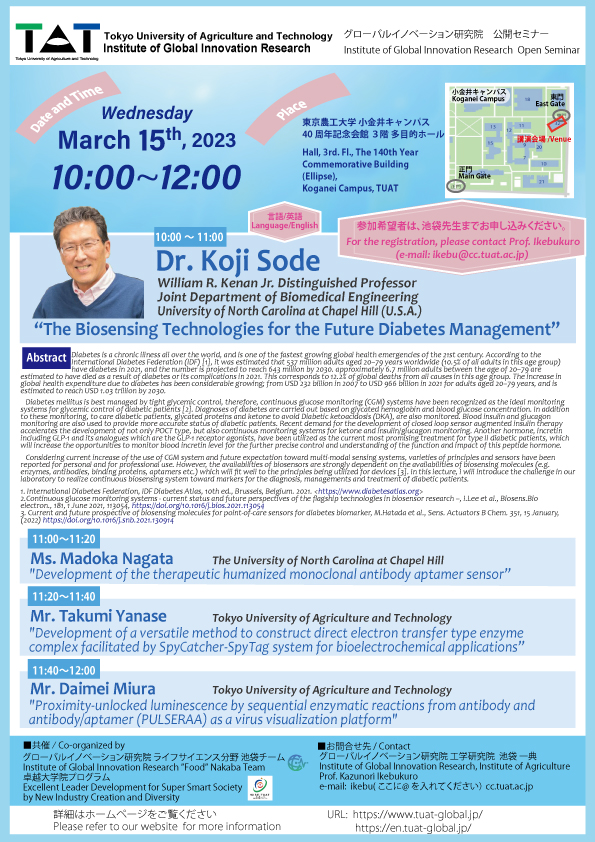Event
【GIR Open Seminar】 Dr. Koji Sode / University of North Carolina at Chapel Hill (U.S.A.)

| Date | 2023.3.15 (10:00 - 12:00) |
|---|---|
| Venue |
Hall, 3rd. Fl., The 140th Year Commemorative Building (Ellipse), Koganei Campus, TUAT |
| Speaker | Dr. Koji Sode |
| Affiliation | University of North Carolina at Chapel Hill (U.S.A.) |
| Title | 1) 10:00〜11:00 Dr. Koji Sode (William R. Kenan Jr. Distinguished Professor, University of North Carolina at Chapel Hill, U.S.A.) "The Biosensing Technologies for the Future Diabetes Management" <Abstract> Diabetes is a chronic illness all over the world, and is one of the fastest growing global health emergencies of the 21st century. According to the International Diabetes Federation (IDF) [1], it was estimated that 537 million adults aged 20–79 years worldwide (10.5% of all adults in this age group) have diabetes in 2021, and the number is projected to reach 643 million by 2030. approximately 6.7 million adults between the age of 20–79 are estimated to have died as a result of diabetes or its complications in 2021. This corresponds to 12.2% of global deaths from all causes in this age group. The increase in global health expenditure due to diabetes has been considerable growing; from USD 232 billion in 2007 to USD 966 billion in 2021 for adults aged 20–79 years, and is estimated to reach USD 1.03 trillion by 2030. Diabetes mellitus is best managed by tight glycemic control, therefore, continuous glucose monitoring (CGM) systems have been recognized as the ideal monitoring systems for glycemic control of diabetic patients [2]. Diagnoses of diabetes are carried out based on glycated hemoglobin and blood glucose concentration. In addition to these monitoring, to care diabetic patients, glycated proteins and ketone to avoid Diabetic ketoacidosis (DKA), are also monitored. Blood insulin and glucagon monitoring are also used to provide more accurate status of diabetic patients. Recent demand for the development of closed loop sensor augmented insulin therapy accelerates the development of not only POCT type, but also continuous monitoring systems for ketone and insulin/glucagon monitoring. Another hormone, incretin including GLP-1 and its analogues which are the GLP-1 receptor agonists, have been utilized as the current most promising treatment for type II diabetic patients, which will increase the opportunities to monitor blood incretin level for the further precise control and understanding of the function and impact of this peptide hormone. Considering current increase of the use of CGM system and future expectation toward multi-modal sensing systems, varieties of principles and sensors have been reported for personal and for professional use. However, the availabilities of biosensors are strongly dependent on the availabilities of biosensing molecules (e.g. enzymes, antibodies, binding proteins, aptamers etc.) which will fit well to the principles being utilized for devices [3]. In this lecture, I will introduce the challenge in our laboratory to realize continuous biosensing system toward markers for the diagnosis, managements and treatment of diabetic patients. 1. International Diabetes Federation, IDF Diabetes Atlas, 10th ed., Brussels, Belgium. 2021. <https://www.diabetesatlas.org> 2. Continuous glucose monitoring systems - current status and future perspectives of the flagship technologies in biosensor research –, I.Lee et al., Biosens.Bioelectron., 181, 1 June 2021, 113054, https://doi.org/10.1016/j.bios.2021.113054 3. Current and future prospective of biosensing molecules for point-of-care sensors for diabetes biomarker, M.Hatada et al., Sens. Actuators B Chem. 351, 15 January, (2022) https://doi.org/10.1016/j.snb.2021.130914 2) 11:00〜11:20 Ms. Madoka Nagata (University of North Carolina at Chapel Hill, U.S.A.) "Development of the therapeutic humanized monoclonal antibody aptamer sensor" 3) 11:20〜11:40 Mr. Takumi Yanase (Tokyo University of Agriculture and Technology) "Development of a versatile method to construct direct electron transfer type enzyme complex facilitated by SpyCatcher-SpyTag system for bioelectrochemical applications” 4) 11:40〜12:00 Mr. Daimei Miura (Tokyo University of Agriculture and Technology) "Proximity-unlocked luminescence by sequential enzymatic reactions from antibody and antibody/aptamer (PULSERAA) as a virus visualization platform" |
| Language | English |
| Intended for | Registration is required. |
| Co-Organized by | Institute of Global Innovation Research "LIFE SCIENCE" Ikebukuro Unit Excellent Leader Development for Super Smart Society by New Industry Creation and Diversity |
| Contact | Institute of Global Innovation Research, Institute of Engineering Prof. Kazunori Ikebukuro Email: ikebu(at) cc.tuat.ac.jp |
| Remarks | ※For the registration, please contact Prof. Ikebukuro (e-mail: ikebu@cc.tuat.ac.jp) |
このページの上部へ